Fabric crochet is simply crochet that’s worked using strips of fabric instead of the usual yarn or crochet thread.
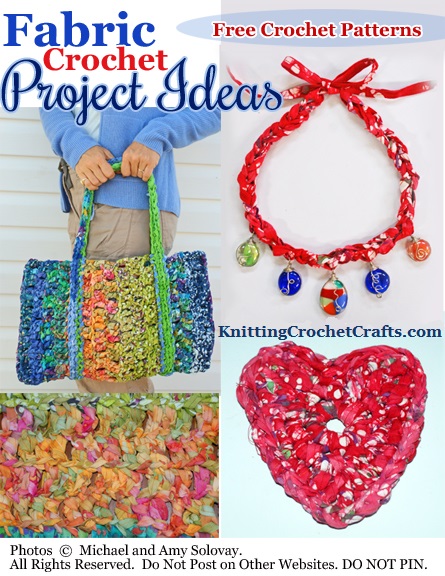
Synonyms for the phrase “Fabric Crochet”: Fabric crochet is also referred to as “rag crochet.”
In general, the phrase “rag work” or the term “ragwork” might be used to refer to the group of techniques that includes fabric crochet as well as fabric knitting, weaving with fabric, braiding with fabric and other upcycling techniques that incorporate used fabrics.
Types of Projects That Are Possible With Fabric Crochet
Crocheting with fabric tends to result in textiles that are thick, heavy and dense. For that reason, it’s well-suited for making items that, by nature, are bulky and structured:
- Rag rugs, floor mats and exercise mats
- Placemats
- Chair pads
- Dog beds and cat beds
- Baskets and bowls
- Tote bags and purses, which are often referred to as “rag bags”
- Pot holders, trivets and hot pads
- Coasters
- Jackets and vests
- Jewelry
Avoid using it for any type of project where a high level of drape is desired; fabric crochet typically does not drape well.
Free Fabric Crochet Instructions
How to Make Rag Balls — Usually, when you crochet, you’d need to use one or more balls of yarn. For fabric crochet, you’ll need rag balls instead. If you have no idea how to make a rag ball, these instructions will get you started.
Tip: Make bunches of different rag balls, in different colors and prints, so you have a nice variety of material to work with. For most projects, you’ll need more rag balls that you could even imagine — so make more than you think you’ll need.
Get Started With Fabric Crochet: Try This Easy Fabric Crochet Project –It might not have occurred to you that you can produce lovely adornments like jewelry using the fabric crochet technique. Not only is it possible, this is an interesting, and enlightening, way to get started with fabric crochet — because it gives you quick insight into whether the technique will agree with you or not.
Fabric crochet necklaces are relatively easy to make, and they’re quicker than just about any other fabric crochet project you might want to try.
Fabric Crochet Patterns
Crochet Rag Rug for the Bathroom or Other Small Space
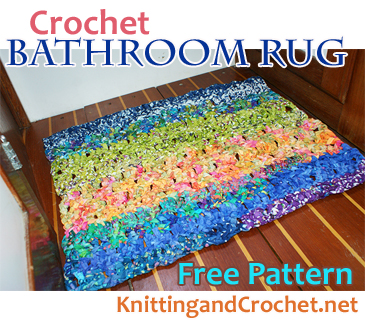
You can use this free crochet pattern to make a small rectangular rag rug that’s the ideal size to use for a bath mat, kitchen mat or welcome mat.
Fabric Crochet Flower Coasters or Trivet Pattern
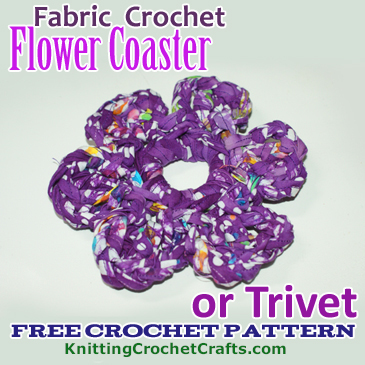
Here’s a crocheted flower that’s a little different from all the other crochet flowers you see around. This one’s different primarily because you crochet it using strips of fabric rather than the usual yarn or crochet thread. This pattern is useful for making lovely coasters, trivets, mug mats or hot pads.
I crocheted the sample project using an interesting batik fabric that looks the same on both sides. Alternatively, I think it would be interesting to use a lively printed floral fabric or a wildly tie-dyed fabric when crocheting this pattern.
Fabric Crochet Heart Coaster Pattern
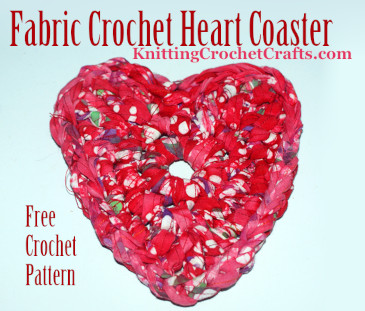
When you’re setting the table for a romantic occasion, there are numerous approaches you could take. If you’re looking for a coaster pattern that’s on the casual side of romantic, this is a good one to consider. The hearts in this design are guy-friendly and not too froo-froo, and will make a nice addition to your table setting at times when you don’t want to overdo the romance theme too much. You can make these heart coasters yourself using the free pattern and instructions we’ve linked here.
Free Rag Bag Crochet Pattern
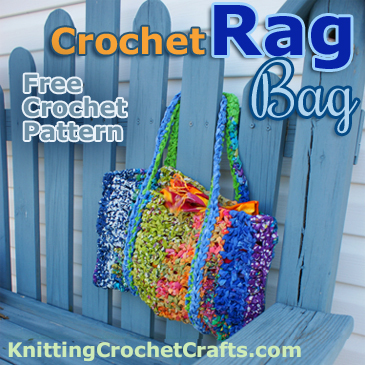
This pattern gives you the information you need to transform fabric strips into a stylish tote bag that’s sleek, chic and unique. It’s perhaps not what you’d expect a “rag bag” to look like, considering that it’s not in the least bit “raggedy.” However, if you want it to be raggedy, that is a possible option; you simply cut the fabric strips on the straight grain instead of the bias so they’re more prone to unraveling.
Amy Solovay designed this fabric crochet tote bag.
Materials for Fabric Crochet
One can use either woven fabrics or knitted fabrics to do rag crochet. However, I recommend choosing one or the other type of fabric for each project, and not combining the two. I make this recommendation because knitted and woven fabrics are structurally different, and they perform differently. They could also be expected to wear differently, and show their age differently as time progresses. The amount of stretch is likely to be different; so is the amount of shrinkage when laundering.
While it is possible to combine the two types of structures, it may be more challenging to achieve consistent gauge when working them, and it might also be more challenging to achieve the results you would ordinarily expect from patterns and project instructions.
For best results with fabric crochet patterns, it’s also advisable to use the same sort of fabric that the designer used when crocheting the original project sample. For example, if the supply list in your pattern specifies t-shirts, it’s a good bet that you want to stick to using knitted fabrics in that particular pattern. You might not be able to achieve exactly the same results if you substitute woven fabrics.
Why Should Anyone Take the Time to Do Fabric Crochet?
There are many reasons you might want to get into fabric crochet. It’s a useful technique to know; it gives you a fantastic outlet for upcycling worn-out old clothing, sheets or linens.
A Fantastic Creative Outlet — Fabric crochet is an engaging craft with many interesting, and useful, applications.
Valuable Finished Projects — Finished fabric crochet projects can have a high perceived value, especially if a high level of craftsmanship goes into the work.
A Frugal Craft Technique: Fabric crochet makes good economic sense, assuming that you crochet with used materials.
Let’s say you want a new area rug for your entryway. One option: you could go to the store and buy a new rug. But, if you happen to have some sheets that are so threadbare, torn and faded that you no longer want to make your bed with them, they’re the ideal material to use for crafting your new rug. In that case, you can cut up the old sheets, crochet them into a new rug, and save the money you would have spent on the rug.
An Environmentally-Friendly Craft Technique: When working with used materials, fabric crochet also makes good environmental sense. In the example above, you’ve taken the old, unusable sheets — textiles that might otherwise have ended up in a landfill — and transformed them into something that will be useful for many years.
From an environmental standpoint, it’s especially critical to ensure that you get the longest lifespan possible out of any conventionally-farmed cotton textile (such as a sheet). This is due to the high amount of environmental harm caused by conventional cotton farming techniques. Cotton farming is responsible for significant amounts of pesticide consumption, and pesticides wreak environmental havoc.
By the time you’ve bought the sheets, the damage is done. At that point, there’s nothing you can do to undo it, but you can at least do your best to ensure that you maximize the lifespan of the cotton item in order to get the most possible long-term benefit from it.
Fabric Crochet History
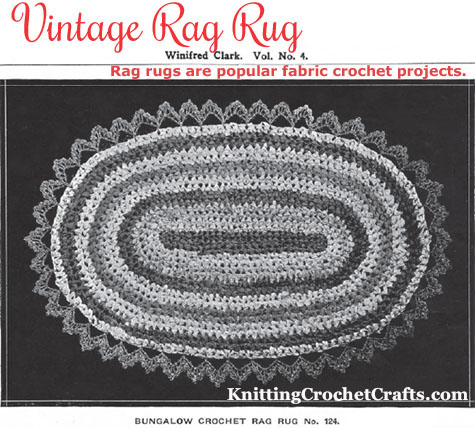
Winifred Clark Bungalow Crochet Book
New Crochet Designs in Bungalow Linens, Household Linens, etc.
Winifred Series Book No. 4
Original Publication Date: 1916
Fabric crochet isn’t a new technique; it’s been around for quite some time, with literature mentioning rag work, knitted rag rugs, and crocheted rag rugs dating back to the 1800s.
There may have been patterns published at this time also, although I haven’t come across any that are quite that old. I’m aware of actual rag rug crochet patterns that were published and available to the public in the 1910s, 20s and 30s. While it’s possible to still find copies of these instructions, they could prove to be disappointing to contemporary crocheters — since the instructions are usually general rather than detailed.
Pictured here is a charming vintage rag rug that was originally designed by Winifred Clark. The project title is “Bungalow Crochet Rag Rug.” The pattern was published in 1916, which was the time period when the Craftsman / arts and craft style was flourishing.
Downsides to Fabric Crochet
My opinion is that, if you have the time to spend on it, fabric crochet’s upsides far outweigh the downsides. However, fabric crochet does have some downsides that crafters should be aware of before seriously pursuing these projects — particularly any projects that would require significant investments of time, money or materials.
A Strenuous Technique
The first downside: fabric crochet can be strenuous, much more so than crocheting with yarn or thread would be. Fabric crochet will work the muscles in your fingers and hands. If you do a lot of other exercise that works your hands out, you may not notice an issue — but if you don’t already exercise much, please don’t be surprised if you find the muscles in your hands becoming sore in the same way that any other muscle would if you were to give it an unexpected workout.
If you’re starting with less-than-healthy hands, the fabric crochet technique is not a good choice for you. Period.
I absolutely do not recommend fabric crochet for anyone who has a history of carpal tunnel syndrome or repetitive stress disorders in their hands.
For everyone else, I recommend using extreme care when crocheting with fabric:
- Pay attention to how your hands are feeling as you crochet each stitch.
- If at any point, you start to feel any pain or fatigue in your hands, it’s time to put the project down and walk away for awhile.
- Don’t pick your fabric crochet project back up again until your hands feel rested, whole and “happy” again.
- Allow plenty of time to finish your fabric crochet projects. They make great gifts, but they DO NOT make great last-minute gifts. If you even suspect that there’s a possibility that you might be pressed for time before presenting your gift to its recipient, choose a different gift. No gift is worth over-exerting your hands and compromising their overall health.
A Time-Consuming Technique
The second downside: From start to finish, fabric crochet projects take more time than projects crocheted with yarn or thread. For starters, you have to add all the time it takes to process your fabrics and transform them into rag balls that are suitable for crocheting with. Then on top of that, the fabric strips themselves are likely to take you more time to work with than yarn or thread would.
This is not an ideal technique for impatient crafters.
If these downsides are non-issues for you, I hope you’ll give fabric crochet a try.
Learn More About Crochet:
- Click here to learn more about crocheting without yarn.
- Click here to find our picks for the best crochet books.
- Click Here to Learn How to Crochet; This Link Takes You to a Total Beginne’’s Guide to Crochet.
- Click here to find crochet stitch tutorials and instructions.
- Click here to learn more interesting crochet techniques.
- Click HERE to Find Fabulous Yarn for Crochet and Knitting
- Click here to learn about crochet hooks.
- Click here to find my favorite crochet project bag.
Learn About Other Crafts: Knitting, Sewing, Quilting, Paper Crafts and More
- Click here to get updated on the latest craft supplies.
- Click here to learn about knitting.
- Click here to find our beginner’s guide to knitting needles.
- Click here to find outstanding craft project ideas.
Posted By: Amy Solovay
Page last updated on 7-6-2023. Thanks for visiting!